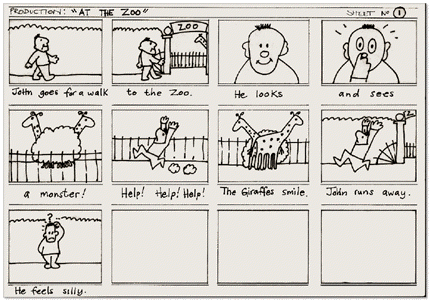
The Thumbnails view displays all the panels in your storyboard, in chronological order, from left to right.

It allows you to add, delete, duplicate, group, reorder, hide, unhide, lock or unlock layers, to enable or disable animation on layers, to change a layer's opacity and to select which layer to draw on, to manipulate or to animate. The Layers panel displays in a section to the right of both the Stage and Camera views. However, if you intend to work with 3D models, to position elements at different distances from the camera or rotate layers in 3D, the difference becomes important: When working in 3D, the Stage view allows you to view the stage from any point of view in the 3D space, whereas the Camera view always previews the stage from the point of view of the camera lens, which means it accurately represents what will appear when you export your storyboard. The Camera view is a lot like the Stage view, and it is not necessary to use it if you only intend to work in 2D. You can draw on layers in the panel, manipulate elements in it as well as create and visualize camera movements. It is used to view and edit the selected panel. The Stage view is the main view in Storyboard Pro. When you get close to the edge of a view, a cyan rectangle appears, indicating where the view will be docked. Drop the window above, below or beside an existing view.Drop the window over another tab to add it to that set of tabs.Click and drag the floating view by its tab and do one of the following:.


 0 kommentar(er)
0 kommentar(er)
